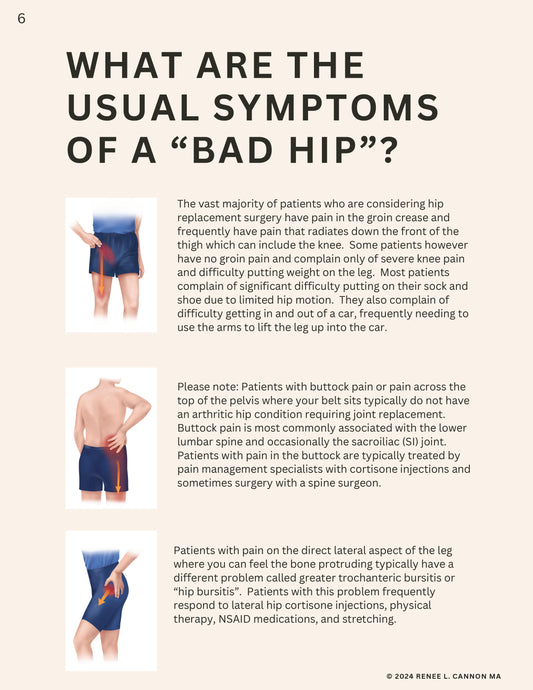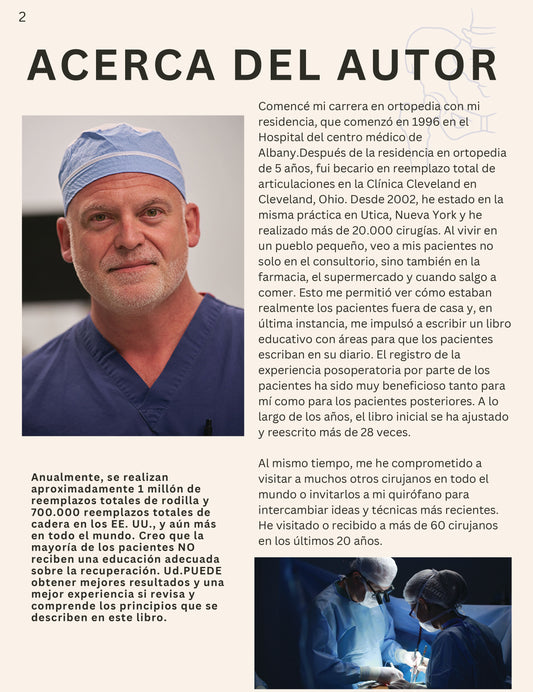Hip Replacement
Hip replacement is a major surgery that must be considered carefully.
Here, Dr. Wickline shares his advice for patients who are wondering if hip replacement is the right option.
If you decide that hip replacement is the right path for you and would like to follow Dr. Wickline’s proven protocols during your recovery, the Less Swelling Less Pain Hip Replacement book is available for purchase.
Dr. Wickline’s plan has helped thousands of patients recover from hip replacement surgery with less pain, less swelling, and reduced need for narcotics. These protocols have also helped many people save money on physical therapy co-pays and increased patient satisfaction post-surgery.
What Is a Bad Hip?
What are the usual symptoms of a “bad hip”? The vast majority of patients who are considering hip replacement surgery have pain in the groin crease and frequently have pain that radiates down the front of the thigh, which can include the knee. Some patients, however, have no groin pain and complain only of severe knee pain and difficulty bearing weight. Most patients complain of significant difficulty putting on their sock and shoe due to limited hip motion. They also complain of difficulty getting in and out of a car, frequently needing to use the arms to lift the leg up into the car.
What is hip arthritis?
Most commonly, hip arthritis refers to osteoarthritis (OA). Osteoarthritis is a degenerative, “wear and tear” disease process where cartilage wears away in the joint causing pain and disability. This degenerative change occurs naturally with aging. In some ways, the cartilage in your hip socket is like the tread on a tire. Some tires are 100,000-mile tires and you never need to replace them. Other tires are only 60,000 miles, and you may have to replace them if you want to keep driving that car.
Things to Consider Before Hip Replacement Surgery
Is hip replacement surgery right for you? Dr. Wickline shares this advice with patients considering hip replacement surgery:
- Hip replacement is meant for individuals who have pain at least 5 days out of 7 per week.
- Your arthritis should be bad enough that you have significantly changed and modified your lifestyle.
- You should dread the stairs, long lines, and large department stores or grocery stores.
- Most patients cannot put on their own sock and shoe or have significant difficulty doing so. They have trouble getting in and out of a car.
- There are multiple ways to access the hip socket during surgery. Two of the most common are anterior approach and posterior approach.
- The anterior approach involves an incision and the work is done from the front of the hip, often without cutting the muscle. This approach is often touted as having less pain and a moderately quicker recovery in the first 3 to 6 weeks compared to the posterior approach.
- The posterior approach requires an incision that does involve some muscle cutting. It has been the workhorse approach for many decades and is still used by about 40% of surgeons. There is no numb spot with this approach, but there is an increased risk for dislocation.
- A reasonable expectation for hip replacement is a 90% reduction in your pain as compared to before surgery. While some patients ultimately report they are completely pain-free, most still have some minor complaints or irritation.
- Young, highly active individuals may have less satisfaction with hip replacement than other patients. Frequently, this is due to having unrealistic expectations.
- Some hip replacement patients occasionally experience a clicking sound or a squeak after surgery, permanently.
- Some patients experience mid-thigh discomfort for up to 2 years after surgery as the thighbone learns to accommodate the implant. There is no fix for this other than time.
- Approximately 1 out of 500 patients will not achieve bone ingrowth into the implant, which may require further surgery to get the desired results.
- The literature suggests it takes at least 10 to 12 weeks to achieve reasonable function. Some patients are able to achieve reasonable function as early as 3 or 4 weeks, but overdoing things too soon may lead to problems.
- It takes at least 6 weeks, if not 12 weeks, to get your sleep pattern back to normal after hip replacement surgery.
- For most patients, hip replacement improves the ability to walk distances, shop, climb stairs, and chase your grandchildren. A realistic assessment of what hip replacement can give you improves the odds that you will be happy with your surgery.
Swelling After Hip Replacement Surgery
Swelling is the most common culprit for postoperative pain. Dr. Wickline advises that patients refrain from excessive exercise and walking in the first two weeks post-op to prevent increased swelling. This is especially important to avoid further complications and achieve a quicker, more comfortable recovery.
Dr. Wickline has teamed up with Dr. Mark Merlin, a vascular surgeon and expert on lymphoedema, to reduce swelling risks after surgery. Together, they recommend following a specific post-op plan that ensures patients have fewer complications and a quicker recovery.
About the Less Swelling Less Pain Total Hip Book
The Less Swelling Less Pain Total Hip guide is designed to walk you through everything you need to know before and after your hip replacement surgery to optimize for your recovery. This book covers:
- How to prepare for recovery
- Optimizing your nutrition ahead of surgery
- A step-by-step plan for your recovery
- And much more

Hip Replacement Information
“Dr. Wickline is a genius! Great bedside manner. Truly cares for his patients. I had a hip replacement and didn’t even need one pain pill. Just Tylenol and ice. His post operative regimen, via a workbook that he gives you, is outstanding. Gives a list of foods to eat and to avoid that helped the healing process and explained everything to expect. Got me back up and running in 3 weeks. Back to work in 4.”
References
- https://journaloei.scholasticahq.com/article/89994 [1]
- https://journaloei.scholasticahq.com/article/77444 [2]
- journaloei.scholasticahq.com/article/18536 [3]
These are the breast cancer recovery materials that inspired Dr. Wickline to write Less Swelling Less Pain: https://educareinc.com/products_books.php
Purchase a Book
-
TOTAL HIP - LESS SWELLING LESS PAIN
Regular price $39.95Sale price $39.95 Regular priceUnit price per -
TOTAL HIP - LESS SWELLING LESS PAIN (SPANISH VERSION)
Regular price $39.95Sale price $39.95 Regular priceUnit price per




